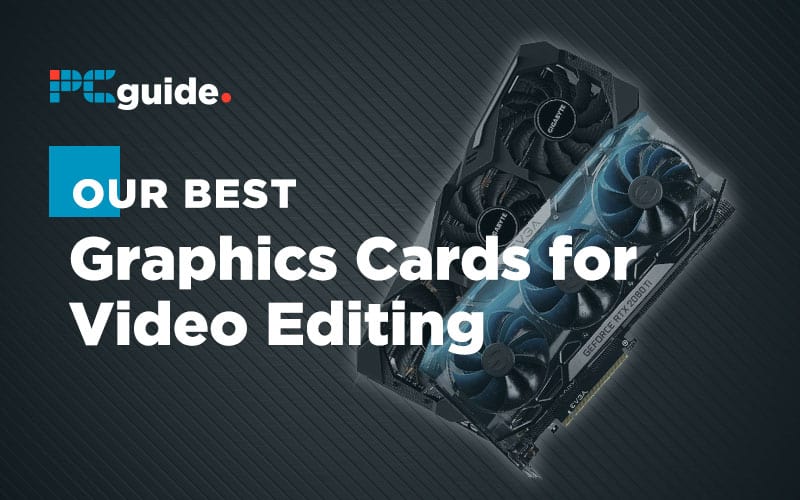When you think of video editing, ensuring that you have a decent amount of RAM and a powerful CPU are the first things that come to mind. However, having a powerful graphics card will not only boost your performance but give you the opportunity to really make your videos/films shine. Many graphical elements such as special effects and motion graphics even require a top tier graphics card to even work, making it even more essential when working in high resolutions like 4k. With this list of best graphics cards for video editing, we’ve tried to give an option for all. Whether you want a top of the line graphics card for intense 4k video editing or a more budget friendly 1080p option, you should be able to pick one for you.
Table of Contents
EVGA GeForce RTX 2080 Ti FTW3 ULTRA GAMING
Best Performing Graphics Card for 4k Video Editing
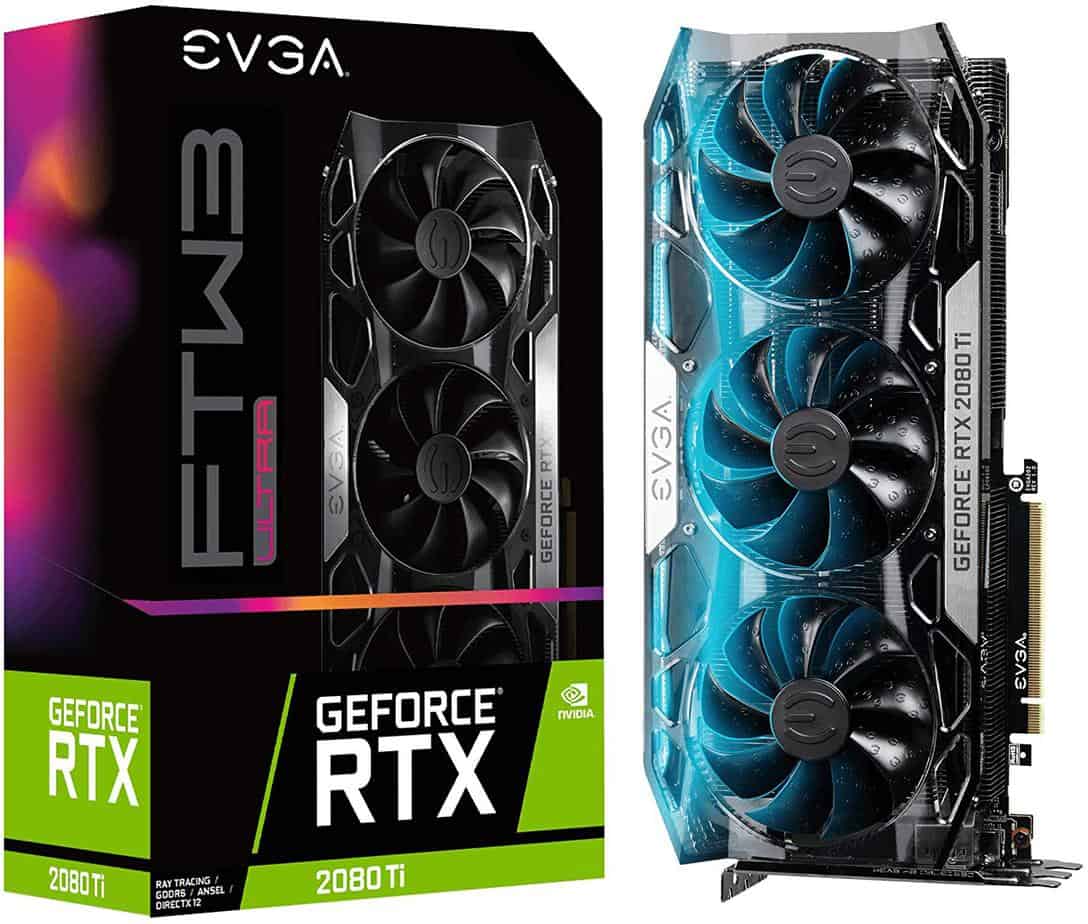
Boost Clock: 1755 MHz
VRAM: 11GB GDDR6
Width: 2.75-Slot
Length: 301 mm
Ports: 3 DP, 1 HDMI
- Top of the line performance
- Great cooling
- Stellar build quality
- Good port options
- Expensive
With the price tag of the Nvidia RTX 2080 Ti, you’re going to be wanting some top of the line performance when video editing. Thankfully, this graphics card delivers. The EVGA variant of the 2080 Ti we’ve chosen here is probably the one to go for, especially for those wanting a more than capable 4k option. It offers up stellar build quality, optimal fan cooling and the all new EVGA Precision X1 software. Looking at the specs of this graphics card, you’re going to be getting a 1,755 MHz boost clock speed as well as 11GB of DDR6 SDRAM perfect for editing and rendering 4k video footage. As well as great specs, with this being a Nvidia GPU, you can utilize Real-Time Ray Tracing, NVIDIA® GeForce Experience, NVIDIA® Ansel, NVIDIA® Highlights and NVIDIA® G-SYNC Compatibility, which can provide you with that slight boost when editing large amounts of 4k footage. With this graphics card being as powerful as it is, it does require a lot of power. So, when either upgrading your current rig or building a new PC, ensure you have a gold rated, high wattage supply to give your components enough juice. After all these positives you might be thinking if there is anything actually wrong with this graphics card and the answer comes when you look at the price. It is a very expensive choice and that’s why we’ve classed it as the best graphics card for 4k video editing and not the best overall.
ASUS ROG Strix GeForce RTX 2080 Super
Best Overall Graphics Card for 4k Video Editing
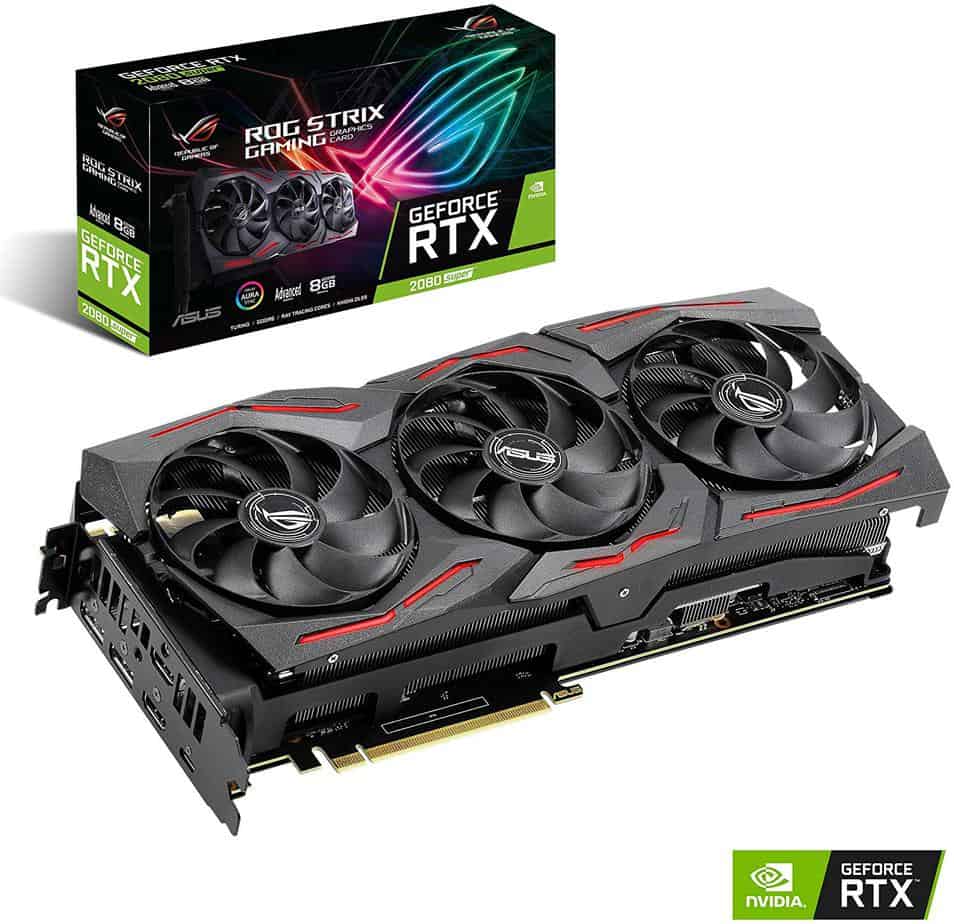
Boost Clock: 1860 MHz
VRAM: 8GB GDDR6
Width: 2.7-Slot
Length: 299 mm
Ports: 3 DP, 1 HDMI
- Fantastic performance
- Cheaper than 2080 Ti
- Good port options
- Lacking in RAM
The 2080 Super is almost the 2080 Ti’s baby brother, providing you with a little less punch but at a much lower cost. You’ll still be getting enough performance to keep up with 4k footage but utilizing a large amount of fancy effects may push it to its limits. Looking at the internals of this thing, there’s 3072 CUDA cores, a boost clock of 1,860 MHz, and 8GB of DDR6 SDRAM which all come together to make a quality piece of kit. In conjunction, due to the ASUS nature of our selection here, you’ll also be taking advantage of FanConnect II and MaxContact technology, monitoring temperatures to ensure optimum levels and improved thermal transfer. The 8GB of RAM is 3GB less than the 2080 Ti, but for the price reduction, it really shouldn’t put anyone off. Speaking of price reduction, you can pick up this ASUS ROG Strix GeForce RTX 2080 Super graphics card for around $500 less than the 2080 Ti which in our minds tips the scales, cementing its place as the best graphics card for video editing, especially 4k footage.
Gigabyte Radeon RX 5700 XT Gaming OC
Best AMD Graphics Card for 1080p Video Editing
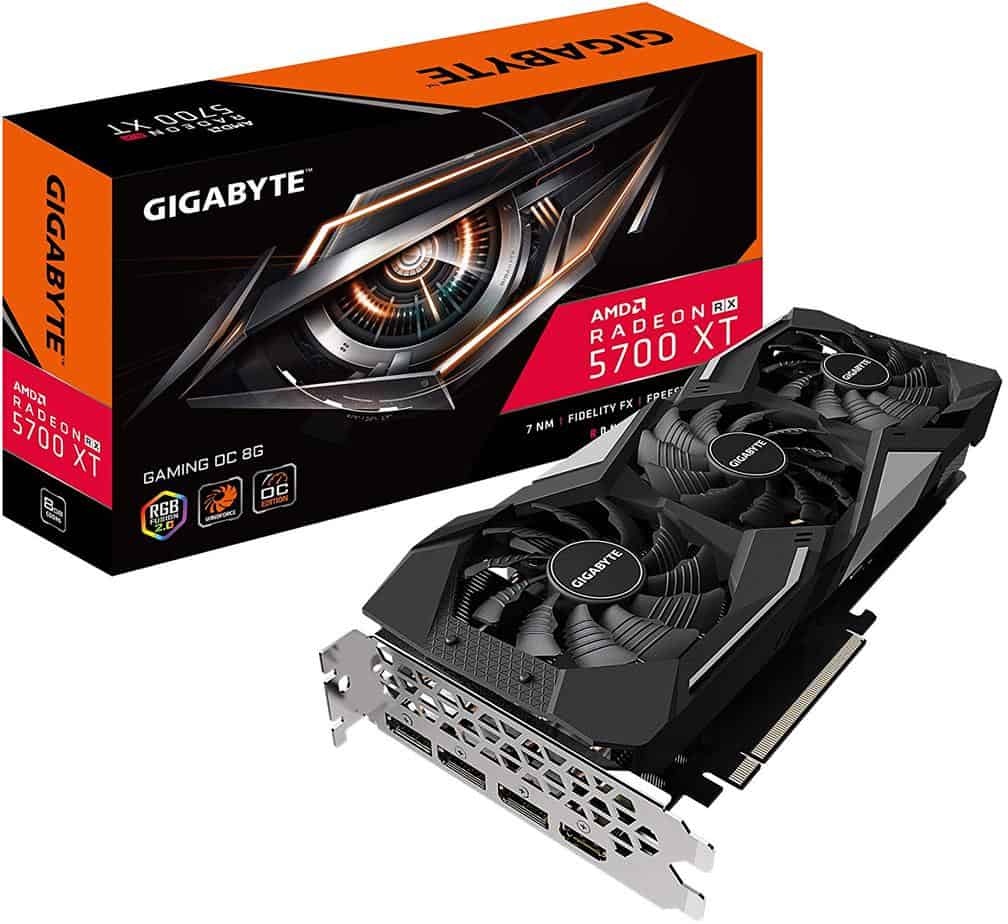
Clock Speed: 1650 MHz
VRAM: 8GB GDDR6
Width: 2.5-Slot
Length: 279 mm
Ports: 3 DP, 1 HDMI
- Best AMD option in this price point
- Great cooling
- Top build quality
- Not as powerful as Nvidia cards
As with our best graphics card for 4k gaming piece, we have similarly included an AMD option for those who can’t bring themselves to part ways with trusty Radeon technology. As stated in that article, AMD graphics cards in this price range really struggle to keep up with their Nvidia counterparts but there are a few exceptions including the Radeon VII and the RX 5700 XT we’ve chosen here. The Gigabyte Radeon Rx 5700 Xt Gaming OC while this graphics card provides extra performance for gaming, it also translates over to video editing. You will be able to edit 1080p video with ease but 4k might be a bit of a stretch. Taking a dive into the specs, we can see it utilizing 7nm Radeon rdna architecture and Radeon image sharpening for crisp display. Additionally, with the inclusion of 3 Windforce alternate spinning fans and 5 direct touch copper heatpipes, your card will be greatly cooled when under intense stress. Overall this card will be more than sufficient to keep up with 1080p video editing with some motion graphics but selecting our next choice, the Nvidia 1660 Ti, will provide you with optimal performance.
MSI Gaming GeForce GTX 1660 Ti
Best Overall Graphics Card for 1080p Video Editing
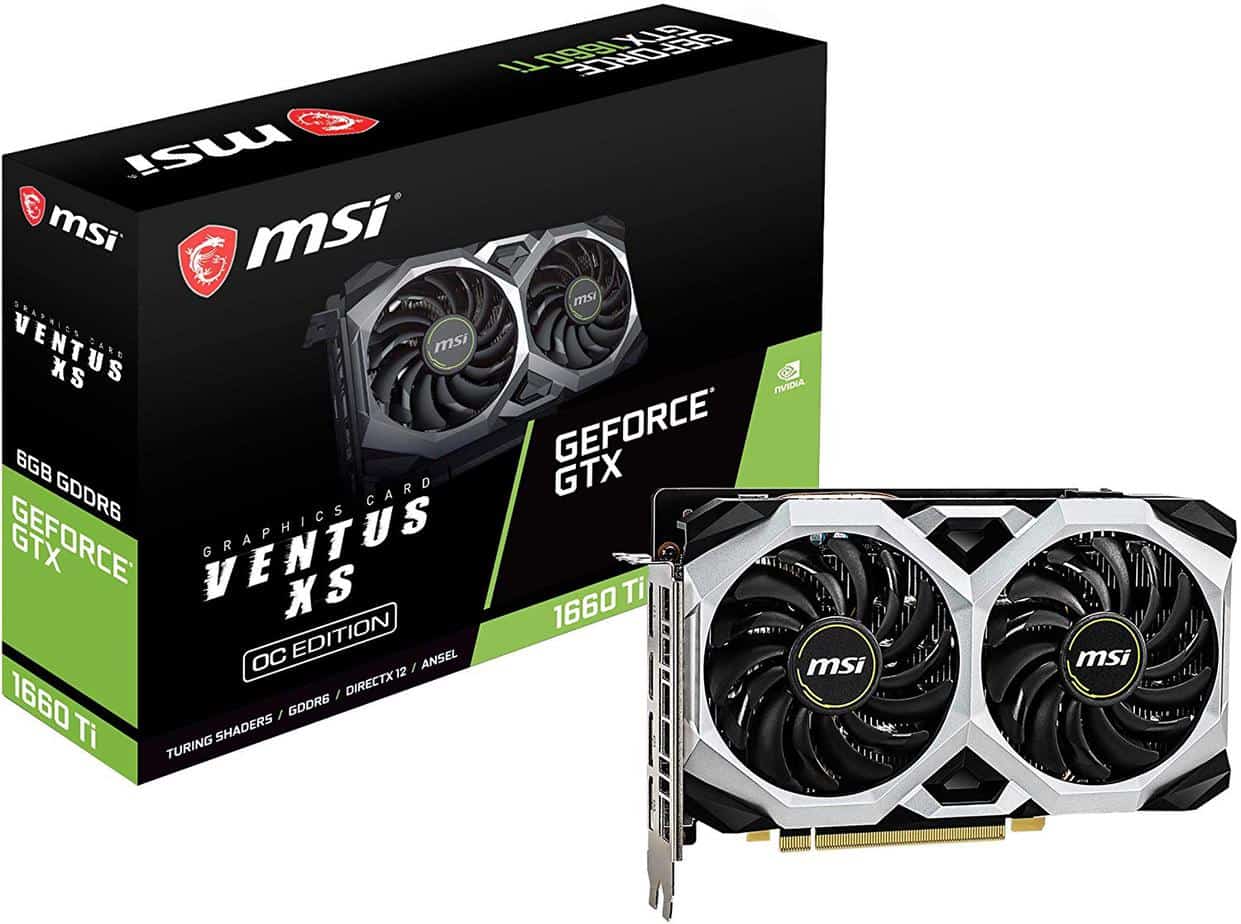
Clock Speed: 1770 MHz
VRAM: 6GB GDDR6
Width: 2-Slot
Length: 247 mm
Ports: 3 DP, 1 HDMI
- Best price vs performance
- Great cooling
- Top build quality
- Not futureproof
The MSI Gaming GeForce GTX 1660 Ti gives you a great bang for your buck. Not only does it give you enough power to cope with 1080p video with an abundance of effects, but can also cope with limited 4k footage. Under the hood of this graphics card is a core clock of 1770 MHz with boostability of up to 1830 MHz, coupled with 6GB of GDDR6 RAM, more than enough for most users. For those looking for a little bit of extra oomph, you could go for a RTX 2060 but it’s around 20% more expensive, hence why we think the 1660 Ti is the better overall option. Due to MSI manufacturing this card you’ll also benefit from some great cooling. The TORX 2.0 fans use a steep curved blade design, accelerating the airflow through and out the graphics card, keeping it ice cold. In conjunction with MSI, because this is another top Nvidia card, can reap the benefits of their technology, ensuring increased performance over our AMD pick; the RX 5700 XT.
XFX Radeon RX 580 GTS XXX Edition GPU
Best Budget Graphics Card for 1080p Video Editing
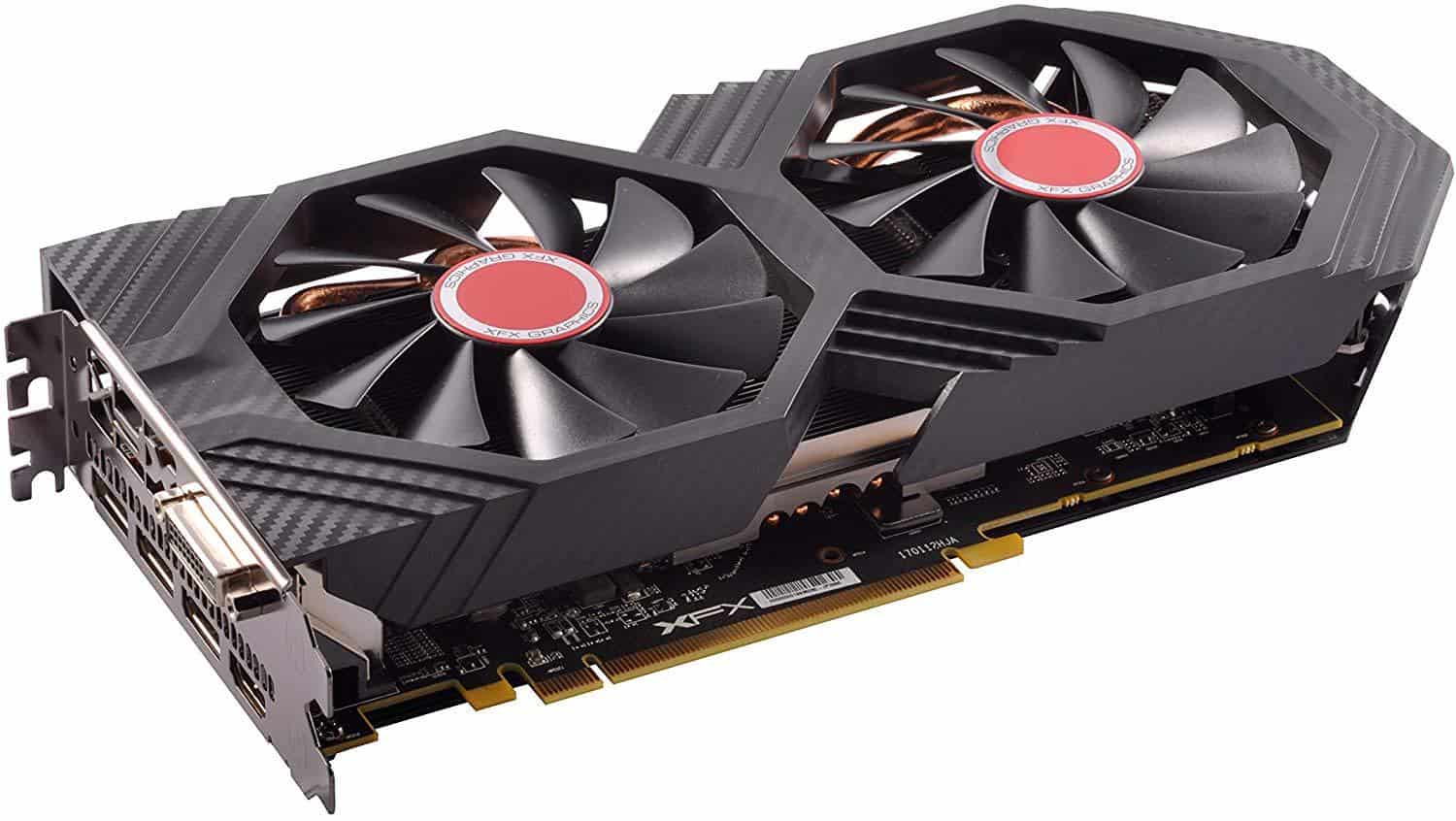
Clock Speed: 1257 MHz
VRAM: 8GB GDDR5
Width: 2-Slot
Length: 270 mm
Ports: 3 DP, 1 HDMI
- Easy on the wallet
- Great 1080p performance
- Top technology
- Not futureproof
- Have to monitor heat levels occasionally
The XFX Radeon RX 580 RS XXX Edition is a common selection in our lower end gaming PC builds due to the price vs performance aspect. Yet again it delivers when looking specifically at video editing. Of course, you’re not going to be able to edit 4k video with this card but what you are getting is a real top performing 1080p video editing graphics card that certainly lives up to the expectations. You will certainly benefit from the 8GB of RAM in this card, allowing for a variety of effects as well as huge amounts of footage to be rendered and edited without lag. Additionally, with XFX manufacturing this graphics card, you can utilize True Clock technology. This tech controls clock speed and optimizes performance, ensuring no dips and spikes. The double dissipation cooling is also a nice added extra, keeping the graphics card at optimal temperature no matter what you throw at it. All in all, as proven in its gaming performance, the XFX Radeon RX 580 RS XXX Edition delivers some top performance at a budget friendly price point making it a sure-fire pick for those not looking to spend huge amounts when editing 1080p video.
Our Verdict
Choosing the right graphics card for video editing is always tricky but hopefully with the options we have listed above, you can come to a conclusion. If you’re hoping to edit 4k video with ease, of course the 2080 Ti and 2080 Super are the way to go. However, deciding between these two is where the deliberations occur. If you’re all about fancy effects and motion graphics, it might be worth shelling out the extra cash for the 2080 Ti to ensure your rig is full capable. On the other hand, if you are just using a lesser amount of said graphics, the 2080 Super is more than sufficient while saving you money in the process.
1080p is a different ball game, requiring much less overall power thus costing less also. You can get by with options like the AMD 580 XXX Edition if you’re on a tight budget but if you’re wanting that buttery smooth experience, opting for an Nvidia 1660 Ti, while more expensive, will keep you going for the foreseeable future.
Additional Information
When choosing the best graphics card for video editing, there are a number of different factors to take into account. If you didn’t understand any of the specifications given in the article above, or you just want a refresher on what they all mean, we’ve provided this section as a buying guide for your reference. Keep reading for a breakdown on each of the key specs we’ve provided, and what they mean to you as a consumer.
GPU Size
GPU Size refers to two different measurements. There’s length, in exact millimeters, and width, measured in slots. Slots refers to both the PCI Express slots that a GPU is inserted into and the slots in the chassis, while length refers to how far into the case the graphics card extends.
Of these two measurements, GPU length is the one that is more likely to cause compatibility issues, especially in a Micro ATX or Mini ITX PC build. Width is really only ever a concern if you plan on installing additional expansion cards, which has become much less necessary with improvements in motherboard I/O and USB adoption.
In any case, be sure to check GPU clearance measurements against those provided by the case manufacturer in specs. You wouldn’t want to buy a massive graphics card that you find out doesn’t fit on the day you’re assembling your build!
GPU Architecture
GPU architecture refers to the technology your GPU is built around. Every card in a certain GPU series will be built with the same architecture, starting with a “pure” version at the highest end. Understanding these will help you better understand the graphics card hierarchy.
Below, we’ve listed the relevant GPU architectures for consumers today:
- AMD Polaris – Used by the RX 500 series, iterative upon past generations.
- AMD Vega – Used by the RX Vega series and the Radeon VII, known for utilizing HBM2 and serving double duty as gaming and professional cards.
- AMD Navi – AMD’s next-gen architecture. Likely to replace Vega and Polaris entirely.
- Nvidia Pascal – Nvidia’s last-gen architecture, used by the GTX 10-Series.
- Nvidia Turing – Nvidia’s current-gen architecture, enabling features like real-time ray-tracing in the RTX 20-Series. The GTX 16-Series is also based on this architecture, but without the extra processing cores for ray-tracing features.
Clock Speed
Clock speed isn’t very useful as a method of comparing different GPUs, especially not across different architectures. If you’re familiar with CPUs, it’s pretty much the same here: clock speed is generally only effective at comparing GPUs with the same architecture. In some cases, clock speed may only be useful for comparing different models of the same GPU, which further complicates matters.
A reference design of a graphics card is one released by the manufacturer as a baseline for others to work with. Nvidia and AMD both release reference designs, which are then iterated upon by companies like MSI and EVGA.
These new designs use aftermarket coolers and may even result in shorter or longer cards, as well as higher out-of-box clock speeds. When a card ships with an above-reference clock speed, this is referred to as a factory overclock, and you will find it is very common in the GPU market.
VRAM
VRAM refers to the memory used exclusively by your graphics card. This differs from standard memory, or RAM, used by the rest of your PC in a few key ways.
VRAM is mainly used for dealing with high resolutions, post-processing effects, and high-fidelity texture streaming. The more VRAM you have, the better your card will be at handling these things… as long as your card can keep up. The type of VRAM used can also be an influencing factor here.
VRAM types, from slowest to fastest:
- GDDR5 – Used by AMD Polaris and Nvidia Pascal GPUs.
- GDDR5X – Used by high-end Nvidia GPUs and low-end Turing GPUs.
- GDDR6 – Used by midrange and high-end Nvidia Turing GPUs.
- HBM2 – Used by AMD Vega cards and high-end Nvidia GPUs.
- VRAM capacities and matching resolutions:
- 2GB – Suitable for 720p and 1080p in most scenarios.
- 4GB – Suitable for 1080p and 1440p in most scenarios.
- 6GB – Suitable for 1440p and VR in most scenarios. 4K needs GDDR6 or better.
- 8GB – Suitable for 1440p, VR, and 4K. The underlying GPU will need to be powerful enough to keep up, though.
In general, if you see two versions of the same card and one version has more VRAM go with that version. It’ll futureproof your system just a little bit more.
Resolution and FPS
When we talk about how each GPU performs, we’ll be mainly referring to its resolution and FPS, or framerate. Below, we’ll provide some explanation for common figures.
Additionally, note that the FPS you can actually see is limited by your display. Most displays only display up to 60 Hz, or 60 FPS. The same applies to resolution, though this is measured the same by games and displays.
Framerate targets:
- 30 FPS – Anything below this is considered unplayable. Not smooth, but not jittery either- just okay.
- 60 FPS – Smooth, and the smoothest that a 60 Hz refresh rate display can show. The ideal target in most scenarios.
- 100 FPS – Very smooth- a common compromise made by those with high refresh rate displays, who want smoother gameplay without totally sacrificing visuals.
- 120 FPS – Ultra smooth.
- 144 FPS and higher – As smooth at it gets.
Tech and Terms
In this section, we’re going to list a few common terms you might see tossed around in this article and in product reviews elsewhere.
- V-Sync – V-Sync is used to prevent screen tearing when a game’s frame rate exceeds a display’s refresh rate. This comes at the penalty of performance loss and more input latency.
- G-Sync and FreeSync – An improved version of V-Sync, corresponding to Nvidia and AMD, respectively. Requires a compatible monitor to function properly.
- Upscaling – The practice of rendering at a lower resolution and upscaling to a higher one. This is used by the upgraded consoles to achieve a 4K image, and is an option in many PC games. However, an upscaled image will never look as a good as a true, “native” image.
- AA (Antialiasing) – Used to remove jagged edges from an image. Especially common and necessary at 1080p and lower resolutions, but becomes less of a hard requirement at higher resolutions.
- SLI, NVLink, and CrossFire – Multi-GPU technologies that have mostly fallen out of favor and support. The first two are Nvidia, the third is AMD. NVLink is the best of the three, but only supported by the highest-end Nvidia GPUs.
- Real-time ray-tracing – The big feature of the Nvidia RTX GPUs vs GTX GPUs. Looks great, but only supported by a few games. Should eventually come to AMD GPUs as well, but is a niche technology for now. (GTX 1060 and newer Nvidia GPUs now support this, but with horrific performance. Thanks, Nvidia!)
- DLSS – An Nvidia-exclusive technology used by RTX GPUs. A form of anti-aliasing fuelled by AI deep learning, allowing far better image quality in supported games.

